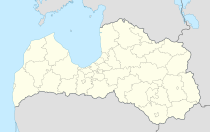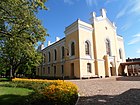Kuldīga
| Kuldīga ( German : Goldingen) | ||
|---|---|---|
 |
|
|
| Basic data | ||
| State : |
|
|
| Landscape: | Courland ( Latvian : Kurzeme ) | |
| Administrative district : | Kuldīgas novads | |
| Coordinates : | 56 ° 58 ' N , 21 ° 58' E | |
| Residents : | 11,768 (Jan. 1, 2016) | |
| Area : | 13 km² | |
| Population density : | 905 inhabitants per km² | |
| Height : | ||
| City law: | since 1347 | |
| Website: | www.kuldiga.lv | |
| Post Code: | ||
| ISO code: | ||
| Brick bridge in Kuldīga over the Venta | ||
Kuldīga ( German Goldingen ) is a city with 12,000 inhabitants (as of 2016) in western Latvia on the Venta River and the seat of the Kuldīgas novads administrative district .
history
At the rapids of the Venta there are settlements of hunters and fishermen from the 2nd millennium BC. Proven. Further downstream on a hill there was a fortification of the Kuren (Alt-Kuldinga) since the early Middle Ages . In 1230, the envoy of Pope Baldwin von Alna signed a treaty with the Curonian ruler Lammekin (Latin: Lammekinus rex ), according to which he changed to the Christian faith and received a larger area around Kuldinga as a fief.
The Livonian landmaster of the Teutonic Order Dietrich von Grüningen built a castle on the rapids after a campaign against the cures in 1242, which was first called Jesusburg and later Goldingen . In 1252 a wooden church of St. Catherine is mentioned. Goldingen had city rights from 1355 and was listed as a member of the Hanseatic League in 1368 . In 1395 Arnoldus de Sacken was enfeoffed with Erkuln and Goldingen.
Goldingen became the residence of Duke Gotthard Kettler in 1561 and later temporarily (during the division of the duchy into a western and an eastern part) the capital of Courland. Under Duke Jakob Kettler, the economy flourished in Goldingen: for example, shipbuilding , saltpeter factories and brick kilns developed.
Due to the Polish-Swedish War and the Great Northern War, as well as a plague epidemic , the city lost its economic and political influence. After the Peace of Nystad in 1721, the Duchy of Courland continued to exist as an independent state under a Polish fief. During this time, Kuldiga developed into a center of organ building . After the third partition of Poland and the dissolution of the Polish-Lithuanian aristocratic republic in 1795, Courland and thus Kuldinga came under Russian rule. The city became the seat of a district chief in the Courland Governorate , one of the three Baltic Governments .
In the 19th century the city experienced a renewed economic boom. The largest companies were the Meteor needle factory , the Vulkan matchstick factory (until 2002) and a leather factory. In 1881 the city already had 9,151 inhabitants. In 1886 the teachers' college was moved here from Riga. In 1896, the first League of Social Democrats of the Baltic States was founded in Kuldinga . After the First World War , Kuldīga came to independent Latvia.
In 1935 a narrow-gauge railway to Liepāja was established.
In 1939 the Baltic Germans , who still made up 13 percent of the city's population, were relocated to the Warthegau as part of the Hitler-Stalin Pact .
In 1940 the Red Army occupied Latvia, which resulted in extensive deportations of the population. After the German Wehrmacht had conquered Kuldīga in 1941, harassment and expropriation of the Jewish residents began, who in 1935 had made up almost a tenth of the population. They were later rounded up in the synagogue and interned there for almost two weeks. Then they were shot dead within two days in the surrounding forests by Latvians from Kuldīga and members of the SS and the Wehrmacht. The belongings of the murdered were auctioned off among the local population .
After the German surrender on May 8, 1945, the Red Army marched into Kuldīga on May 10, 1945. Until then, the city in the Kurland basin had been held by the Kurland Army Group of the Wehrmacht, including Latvian units.
In the Soviet period from 1945 to 1990/1991, Kuldīga was a district town where industry was settled: among other things, wood processing industry, a factory for reinforced concrete prefabricated parts and a textile factory.
coat of arms
Goldingen already had a seal at the time of the order, in the center of which was Saint Catherine of Alexandria . The city coat of arms shows the holy patroness standing in the middle, white on red, with arms spread out. In her right hand she holds the straightening wheel with a chain with a cross around it. The left hand rests on a sword pointing downwards. The current shape was officially approved in 1938.
Attractions
- former castle of the Teutonic Order from 1248
- St. Catherine's Church, originally from the 13th century, later changed with a baroque altar
- Town hall, 19th century
- The brick bridge from the 19th century with 164 meters the longest navigable by car brick bridge in Europe.
- The rapids of the Venta ( German Windau ) are the widest in Europe at 270 to 275 meters.
- Riežupes smilšu alas (Riežuper Sand Caves), a former quartz sand mine
- The synagogue had one of the most splendid interiors in Latvia. In the early 1950s it was converted into a cinema. For this purpose, a ceiling was put in at the level of the women's gallery, stairwells were built in and the main entrance to the place of the Holy Ark, the Aron ha-Qodesch ( Torah shrine ), was broken. The cinema closed a few years after the end of the Soviet Union. The town library has been located in the building of the former synagogue since 2011, including a collection of books on the history of the Jewish people.
Rapids on the Venta (Lat .: Ventas rumba )
Town twinning
- Since 1991 there has been a town partnership with Geesthacht in Schleswig-Holstein (Germany). Other twin cities are Mtskheta in Georgia and Drøbak in Norway.
- Kuldīga is a member of the New Hanseatic League and participated several times in the Hanseatic Days of Modern Times .
sons and daughters of the town
- Jakob Kettler (1610–1682), Duke of Courland, grandson of the last Teutonic Order Master Gotthard Kettler
- Karl Juljewitsch Dawidow (1838–1889), Russian composer, conductor, cellist and music teacher
- Oswald Bauer (1876–1936), German-Baltic metal physicist
- Sergei Michailowitsch Tretyakov (1892–1937), Russian writer
- Max Weinreich (1894–1969), a linguist specializing in Yiddish
- Karl-Otto Schlau (1920–2001), German-Baltic administrative lawyer
- Robert Rosentreter (1931–2015), German naval officer and military journalist
- Guntars Sietiņš (* 1962), graphic artist, medalist and university lecturer
- Andris Reiss (* 1978), racing cyclist
- Jānis Miņins (* 1980), bobsledder
- Dana Reizniece-Ozola (* 1981), chess player and Minister of Finance of Latvia
- Linda Krūmiņa (* 1984), chess player
- Toms Šmēdiņš (* 1986), beach volleyball player
- Jānis Šmēdiņš (* 1987), volleyball and beach volleyball player
Kuldiga County (Kuldīgas novads)
After the Kuldīga district was dissolved, there is now an administrative community of the city with 13 surrounding communities. In 2014 there were 25,823 inhabitants in the Kuldīgas novads district .
literature
- Ernst Henning: History of the city of Goldingen in Courland. Mitau 1809 digitized .
- as a reprint : von Hirschheydt, Hannover-Döhren 1973, ISBN 3-7777-0952-2 .
- Hans Feldmann , Heinz von zur Mühlen (Hrsg.): Baltic historical local dictionary, part 2: Latvia (southern Livland and Courland). Böhlau, Cologne 1990, ISBN 3-412-06889-6 , pp. 187-190.
- Sigurds Rusmanis, Ivars Vīks: Kurzeme . Izdevniecība Latvijas Enciklopēdija, Riga 1993, ISBN 5-89960-030-6 , pp. 103-110 (town history and explanations of numerous sights, Latvian).
- Astrīda Iltnere (ed.): Latvijas Pagasti, Enciklopēdija. Preses Nams, Riga 2002, ISBN 9984-00-436-8 .
Web links
- Kuldīga website. Retrieved May 13, 2014 .
Individual evidence
- ^ A History of the Organ in Latvia , The Diapason, July 23, 2007, accessed October 12, 2019
- ↑ Andrew Ezergailis: The Holocaust in Latvia, 1941-1944. The missing center. Historical Institute of Latvia, Riga 1996, ISBN 9984-9054-3-8 , p. 403.
- ^ Information on the library website , accessed on September 27, 2012.
- ↑ Website Kuldīga - Twin Towns ( English ), accessed on November 10, 2018








